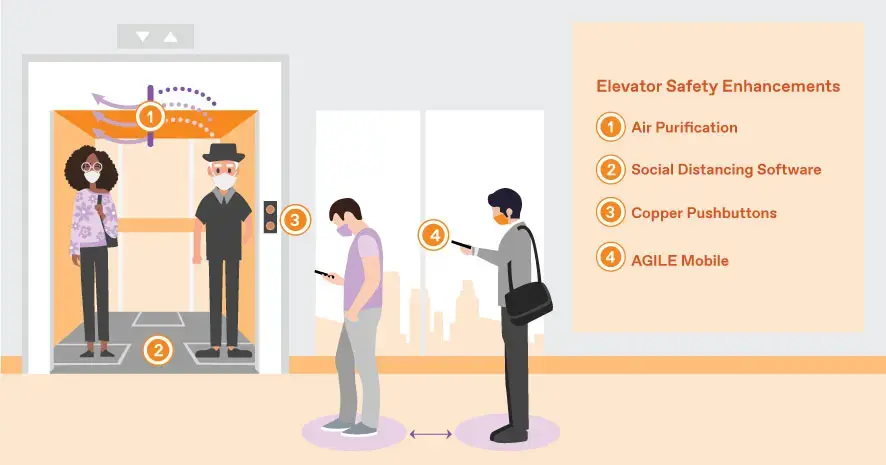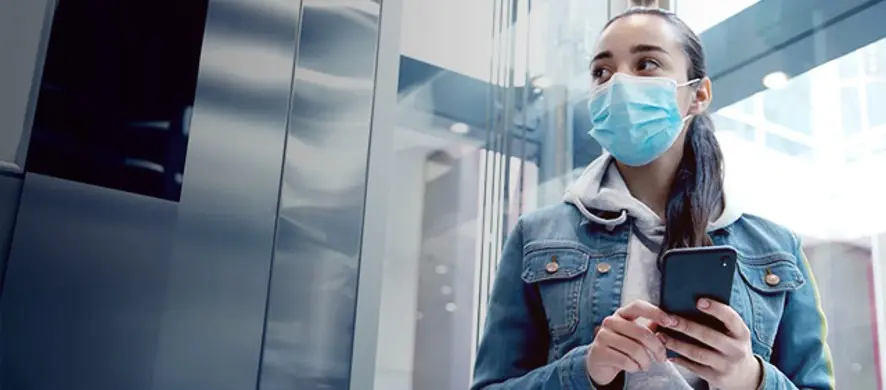Elevator Enhancements to Keep Returning Workers Safe
By Kevin Robertson, Senior Vice President of Sales, TK Elevator North America
As the U.S. nears the summer of 2021, you’ve probably heard the question on many Americans’ minds: when, if ever, will companies bring their full workforces back into offices?
With widespread vaccinations taking place and office building elevator activity rising to 52% of pre-COVID-19 levels in April 2021 (up from 30% in April 2020), there are growing signs that office returns could be getting closer.
While there’s still no consensus on office return timelines, tenant trepidation could derail return-to-work plans if property managers do not take the necessary precautions to ensure the safety of anyone setting foot in their building. One of those key stressors for returning workers is the elevator — but it shouldn’t be.
There are a variety of elevator enhancements that building owners and managers can implement to ensure their facilities handle workforce returns and, more importantly, keep workers safe.

Heading to the elevator
From the moment someone sets foot in a building, their safety is the responsibility of every property manager. Technology has enabled smarter building management in recent years, and the elevator is no exception. Digital technology can be a critical asset in any building’s return-to-work plans as it can allow building managers to better control traffic flow.
To start, there are applications like AGILE Mobile that allows tenants to request an elevator before they even enter the building, and have a pre-selected elevator waiting for them upon arrival. You can dispatch an elevator through a smartphone app or a wearable device, such as a smart watch, and you will not have to touch any public elevator buttons.
This technology can also help eliminate elevator wait times and lobby congestion. It’s made possible through its connectivity to the elevator’s Destination Dispatch system.
While it's elevator urban legend that the idea for Destination Dispatch was conceived back in the early 1960s, its practical application wasn’t pioneered until the 1990s. Its purpose was simple: reduce passenger travel time by grouping passengers with the same destinations together to reduce or eliminate stopping at unnecessary floors.
But what about limiting the number of passengers per elevator?
Social distancing software exists that can help tenants stay safe by limiting elevator passengers to maintain physical distance. The software assesses a building’s elevator traffic so property managers can balance building congestion risk while ensuring a small number of passengers is assigned to an elevator. Once an elevator reaches its newly established capacity limit — such as two to four passengers — the software will either direct passengers to another elevator or they will have to wait for that elevator to return.
Using the data captured by the MAX IoT device, building managers can use that actionable intelligence to better balance passenger wait times and social distancing needs through a simple algorithm adjustment.

Inside the elevator
You have the signage and digital technology devices to safely manage returning office workers. Now what? One step a property manager can take is to focus on the air quality.
Air quality inside an elevator can be improved with air purifying devices that feature Needlepoint Bipolar Ionization (NPBI) technology. NPBI uses an electronic charge to create a high concentration of positive and negative ions, and the generated ions travel through air inside elevators and attach themselves to pathogens including viruses and bacteria. That contact disrupts surface proteins, rendering them inactive and unable to replicate.
The device safely and continuously cleans elevators with no harmful byproducts and reduces odor inside elevators. Not only can this simple upgrade be easily installed within the intake system on top of the elevator, but there is no routine maintenance or cleaning required.
Next comes selecting the floor once inside the elevator in buildings without Destination Dispatch. Copper pushbuttons can be easily retrofitted into existing elevators and offer numerous safety benefits. The pushbuttons are self-cleaning and vandal-resistant and can be easily cleaned with a water-to-vinegar solution. Copper is used by healthcare facilities and other high-traffic buildings to supplement infection control practices and further enhances the safety of the passenger journey.
As a bonus, LED buttons are available in a variety of colors to add an aesthetically pleasing component to the elevator.
Looking ahead
With widespread returns to the office appearing to be closer, every commercial property manager has a responsibility to their tenants to do everything they can to ensure their safety. Investing in simple elevator enhancements can mean the difference between healthy and happy office workers and an empty building.
 United States
United States

